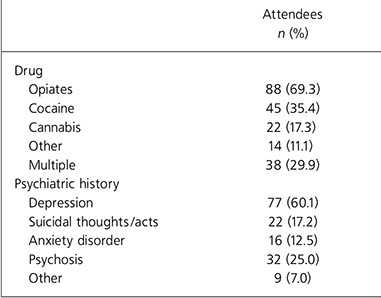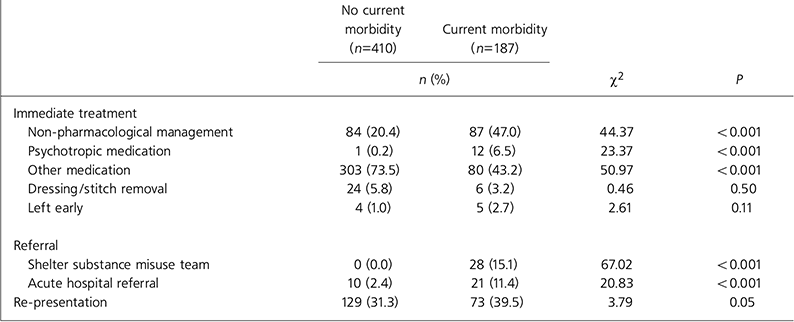Studies from around the world have repeatedly shown rates of depression, anxiety, substance misuse and psychosis which are several times higher in the homeless than in housed populations (Reference KOEGEL and BURNAMKoegel et al, 1988; Reference FICHTER and QUADFLIEGFichter & Quadflieg, 2001; Reference HAN, LEE and AHNHan et al, 2003). Data from the UK suggest that 70-80% of homeless people have at least one lifetime psychiatric diagnosis, 30-50% report acute psychological distress and at least 20% show comorbid substance misuse and mental illness (Reference SCOTTScott, 1993).
However, the impact of mental disorder on the provision of overall healthcare to this population is less clear. This study aimed to assess recording of psychiatric morbidity among attendees at the medical centres of open access winter shelters run by the homelessness charity Crisis. It also examined associations between the presence of current psychiatric symptoms and treatment received.
Method
The Crisis Open Christmas is a group of open access winter shelters available in London over the Christmas week, attended mainly by those living on the streets or in insecure accommodation such as hostels (see http://www.crisis.org.uk/coc). The shelter medical centres are staffed by volunteer clinicians and provide emergency medical care, primary healthcare and health education. Attendees are initially triaged by nurses, who use a standardised medical form to record demographic and housing information, usual sources of healthcare, past medical and psychiatric history (specifically including asthma, diabetes, hypertension, tuberculosis, fits, alcohol misuse, drug misuse and mental health problems), smoking status, current medications and drug allergies. In addition, the presenting complaint is detailed. Definitive assessment and treatment is provided by the most appropriate member of the clinical team, for instance a physician, psychiatrist or nurse.
During November 2003, as part of a strategy to improve assessment and management of psychiatric disorder within the Crisis Open Christmas, medical records for attendees at the 2002 Crisis medical centres were examined. All attendees who had seen a doctor or nurse were eligible for inclusion in the study. Those who left the medical centre before details of the presenting complaint had been recorded were excluded.
Demographic information and data on reported lifetime and current mental health problems and substance misuse were extracted from the medical records. Details of illicit drugs used and previous psychiatric diagnoses were not required by the assessment schedule, but were often recorded by clinicians or could be inferred from reported medication. Where the current presentation included signs or symptoms of psychiatric illness or substance misuse, symptom type and diagnosis given were noted.
Outcomes of the consultation were defined as:
-
• immediate treatment offered
-
• referral to shelter substance misuse team
-
• acute referral to external medical, surgical or psychiatric facility
-
• later re-presentation to shelter medical service.
These outcomes were compared between those with and those without current psychiatric symptoms, using χ2 tests to assess the statistical significance of findings. All data were analysed using SPSS version 10 for Windows.
Results
Of 649 attendees, 597 (92.0%) were eligible for inclusion, and 52 (8.0%) were excluded because they left before their presenting complaint had been recorded; 202 (33.8%) attended more than once. The mean age of attendees was 40 years (range 16-78, s.d.=12.9) and 83.8% of attendees were male. Data on ethnicity were absent in 28.8%; of those remaining, 85.6% identified themselves as British or White. Out of 597 attendees, 51.1% defined themselves as rough sleepers, 13.8% lived in hostels and 21.1% were housed.
Physical health
Reported physical illness was common, including 17.6% with registered disability, 26.0% asthma, 14.3% fits, 13.2% hypertension, 4.8% diabetes and 4.1% tuberculosis. Smoking was reported by 74.6%. At least one usual source of healthcare was reported by 75.4% of attendees, including 58.3% from a general practitioner or primary healthcare team for the homeless. There were 414 (69.3%) who gave information on current medication, of whom 198 (47.8%) were taking medication for physical health problems, 107 (25.8%) for mental health problems and 152 (36.7%) were taking no medication.
Past psychiatric history
Information on previous mental illness, excess alcohol use and illicit drug use was missing for 13.2, 10.7 and 12.2% of attendees respectively. Of the remainder, 209 (39.1%; 95% CI 35.0-43.3) reported excess alcohol use, 186 (35.4%; CI 31.3-39.5) illicit drug use and 187 (36.0%; CI 31.9-40.2) mental health problems. Of the 506 for whom information was available on all three, 103 (20.4%; CI 16.9-23.9) reported comorbid substance misuse and mental health problems. Details of specific drugs recorded (n=127) and psychiatric history (n=128) are given in Table 1.
Table 1. Details of lifetime drug misuse (n=127) and past psychiatric history (n=128)

| Attendees n (%) | |
|---|---|
| Drug | |
| Opiates | 88 (69.3) |
| Cocaine | 45 (35.4) |
| Cannabis | 22 (17.3) |
| Other | 14 (11.1) |
| Multiple | 38 (29.9) |
| Psychiatric history | |
| Depression | 77 (60.1) |
| Suicidal thoughts/acts | 22 (17.2) |
| Anxiety disorder | 16 (12.5) |
| Psychosis | 32 (25.0) |
| Other | 9 (7.0) |
There were 107 attendees (25.8% of those giving information on medication) who reported currently prescribed psychotropic medication, including 26 using antipsychotics (6.3%); 47 (7.9%) were recorded as known to psychiatric or substance misuse services, although this information was not routinely requested.
Current symptoms and association with outcomes
There were 187 attendees (31.3%, 95% CI 27.6-35.0) who had current psychiatric signs or symptoms recorded during at least one consultation. As shown in Table 2, both presenting complaints and diagnoses given in these attendees were predominantly related to physical disorder or substance misuse. Diagnosis of depression and anxiety was unusual.
Table 2. Presenting symptoms (n=187) and diagnoses given (n=137)

| Attendees n (%) | |
|---|---|
| Symptom | |
| Physical | 115 (62.5) |
| Intoxication/withdrawal/detoxification request | 53 (28.8) |
| Low mood/anxiety | 35 (19.0) |
| Medication request | 24 (13.0) |
| Social problems | 22 (12.0) |
| Suicidal thoughts/acts | 11 (6.0) |
| Psychotic symptoms | 11 (6.0) |
| Other psychiatric symptoms | 13 (7.1) |
| Diagnosis | |
| Drug intoxication/withdrawal/misuse | 36 (26.3) |
| Alcohol intoxication/withdrawal/misuse | 29 (21.2) |
| Physical complications of substance misuse | 20 (14.6) |
| Psychosis | 10 (7.3) |
| Depression/anxiety | 9 (6.6) |
| Other psychiatric disorder | 8 (5.8) |
| Physical disorder | 25 (18.2) |
Table 3 shows highly significant associations between current psychiatric morbidity and outcome of the Crisis Open Christmas consultation. These include increases in initial non-pharmacological management (assessment and reassurance, healthcare advice, or referral to shelter Samaritan service), referral to the shelter substance misuse team, referrals to hospital (medical and psychiatric) and re-presentation to the shelter medical centre. Overall, this represents an increased use of healthcare resources.
Table 3. Outcome according to presence of current psychiatric morbidity

| No current morbidity (n=410) | Current morbidity (n=187) | |||
|---|---|---|---|---|
| n (%) | χ 2 | P | ||
| Immediate treatment | ||||
| Non-pharmacological management | 84 (20.4) | 87 (47.0) | 44.37 | <0.001 |
| Psychotropic medication | 1 (0.2) | 12 (6.5) | 23.37 | <0.001 |
| Other medication | 303 (73.5) | 80 (43.2) | 50.97 | <0.001 |
| Dressing/stitch removal | 24 (5.8) | 6 (3.2) | 0.46 | 0.50 |
| Left early | 4 (1.0) | 5 (2.7) | 2.61 | 0.11 |
| Referral | ||||
| Shelter substance misuse team | 0 (0.0) | 28 (15.1) | 67.02 | <0.001 |
| Acute hospital referral | 10 (2.4) | 21 (11.4) | 20.83 | <0.001 |
| Re-presentation | 129 (31.3) | 73 (39.5) | 3.79 | 0.05 |
Discussion
This large, cross-sectional study is unusual in focusing on psychiatric morbidity routinely recorded during primary care consultations among a predominantly homeless population. Recorded prevalence of both lifetime and current psychiatric morbidity was high, and current symptoms were associated with increased health service use.
Recorded rates of lifetime and current psychiatric morbidity in this study are comparable to those seen in previous research using self-report measures (Reference SCOTTScott, 1993; Reference GILL, MELTZER and HINDSGill et al, 1996), although use of observer report, longitudinal measures and diagnostic instruments is known to be associated with higher recorded rates of disorder in this population (Reference GOLDFINGER, SCHUTT and SEIDMANGoldfinger et al, 1996). As in other studies (Reference BRIDGES and GOLDBERGBridges & Goldberg, 1985; Reference FELDMAN, MAYOU and HAWTONFeldman et al, 1987), many attendees with psychiatric morbidity presented with physical symptoms or acute problems related to substance misuse. Depression and anxiety were rarely diagnosed, and a diagnosis of substance misuse was frequently not followed by referral to substance misuse services, suggesting that important opportunities for intervention were missed.
Overall, few psychotropic medications were prescribed, as the Crisis Open Christmas medical service does not dispense benzodiazepines, atypical antipsychotics or antidepressants. Given the known association between physical and psychological morbidity in the homeless (Reference GILL, MELTZER and HINDSGill et al, 1996; Reference DESAI and ROSENHECKDesai & Rosenheck, 2005), the association between current psychiatric morbidity and reduced overall medication prescription at the Crisis Open Christmas is surprising. However, increased rates of both acute referral outside the shelter and re-presentation within the shelter demonstrate that the high level of health need typically found in homeless people with mental illness is associated with increased health service use, particularly for acute services (Reference STEIN and GELBERGStein & Gelberg, 1997).
Although the large sample size and small number of attendees excluded because of lack of information are important strengths of the study, there are also some limitations. As a retrospective study, it relied on good-quality data having been collected during routine clinical practice, and levels of missing data were of concern for some items. No diagnostic measures were used, and the true prevalence of psychiatric disorder in the sample is therefore unknown. The unusual service context of the study also means that generalisation may be difficult, although the demographic similarity between this and previous samples of homeless people in Britain is encouraging. Finally, since these data are cross-sectional, the impact of the high incidence and remission rates of mental illness in the homeless is unclear (Reference FICHTER and QUADFLIEGFichter & Quadflieg, 2005). Further longitudinal data are therefore essential to inform service planning.
Although previous studies have explored both clinical and economic aspects of different models of service provision for homeless people with mental illness (Reference ROSENHECKRosenheck, 2000), the challenge of creating an initial engagement with services remains. In this context, opportunities to identify and treat mental health problems must be taken whenever possible. Interventions within the shelter environment have the potential to increase engagement with mainstream services (Reference BRADFORD, GAYNES and KIMBradford et al, 2005), and this is particularly important for the Crisis Open Christmas, which operates for only 1 week per year. The impact of mental health training for shelter staff has received little attention (Reference VAMVAKAS and ROWEVamvakas & Rowe, 2001), but this study suggests that improved training of Crisis staff in the detection and management of mental health problems should be instituted, and its impact be systematically evaluated. Such training should aim to increase engagement with mainstream mental health services as the first step towards reducing the burden of psychiatric morbidity in this vulnerable group.
Declaration of interest
M.H. worked as an unpaid volunteer in the Crisis Open Christmas medical service.
Acknowledgements
I thank Roger Williams and other Crisis staff for their support. The findings were presented as a poster at the 2004 Annual Meeting of the General and Community Faculty of the Royal College of Psychiatrists and won the trainee research prize. Professor Martin Prince and Dr Rajesh Mohan offered advice on earlier versions of this paper.






eLetters
No eLetters have been published for this article.